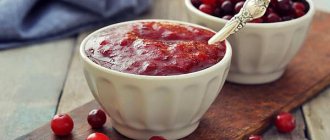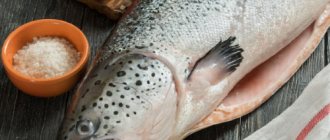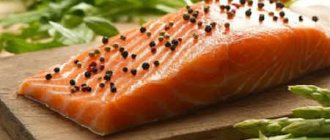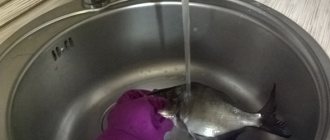It happens that various tasty things fall into our hands at the wrong moment.
If the product you received has a long shelf life, this is not a problem - just hide it until you are ready to eat it. But what about truly perishable products?.. Fresh fish is one of these products, and without proper preparation, even in the refrigerator, it will “live” no longer than 24 hours. In this article we will talk about how to properly store fish in order to maximize its freshness. 10 simple recipes for dinners in 15 minutes Enter your email and get a recipe book - instantly and for free![/td]
How to preserve fish if it is still alive
The simplest and most affordable way to preserve live fish is to wrap it in soaked burdock or nettle leaves and place it in a cool shade. With this storage method, some fish species, for example, crucian carp, carp, and tench, can remain alive for up to two to three days. If the weather is hot, you can use a cage lowered into the water in a shaded place to store live fish. However, we must remember that this method is only suitable for storing live fish; dormant fish cannot be stored in water, as it will quickly deteriorate.
Features and shelf life of chilled fish
The best possible option is to purchase the product in such quantity that it can be prepared immediately.
But situations are different, so it’s better to know how to store fresh fish. Shelf life differs for each type: smoked, salted, fresh, minced, whole carcass or caviar. For example, chilled fish has a shelf life of no more than three days - and the temperature in the refrigerator must be maintained from -2°C to 0°C. In ordinary refrigerators the temperature is 5-6°C, so the storage time is reduced to a day.
The most popular way to store raw fish is to gut it, rinse it and store it in an airtight container.
But there are other options to delay the spoilage of the product: freezing, salting, smoking, canning and drying. Whatever method you choose to store fresh fish in the refrigerator, remember that it should be placed as far as possible from other products. Otherwise, other products will absorb the smell of fish, and the fish will absorb their smell. This is especially true for dairy and meat products.
How to preserve fish if it has already fallen asleep
If the fish “fell asleep”, you can preserve it for up to 12 hours by salting its gills and slightly drying it. To do this, the prepared fish is hung in a shaded, ventilated place and covered with gauze to protect it from flies and other insects.
If the fish is large enough, it makes sense to first carefully gut it and remove the gills. The dried fish is covered with nettles, placed in a basket and put in the shade.
In cool weather (spring or autumn), the shelf life of fish is 1-2 days. Just hang it in a dry, ventilated place. If you remove the gills from the fish and gut it, the shelf life of the fish can increase to 4 days.
To preserve fish for 3 days, you can use the simplest natural preservatives: salt, sugar, vinegar. It is necessary to dissolve 1 - 2 heaped teaspoons of sugar in half a liter of 9% vinegar, soak a cloth napkin with this solution and wrap it around the fish, previously sprinkled with salt.
How to store fresh fish at home
Freshly caught fish has the best taste and nutritional qualities. The longer the time passes after her euthanasia, the more, under the influence of internal enzymes and external bacteria, the breakdown of beneficial nutrients and oxidation (spoilage) processes begin. Therefore, after purchasing or catching fish, it is important to preserve the product as quickly as possible.
Cooling
This canning method is suitable for short-term storage of fish. It is convenient in cases where there is no time for more complex preparations or the product is planned to be prepared quickly.
The method is based on lowering the temperature in the thickness of fish meat to −1°C. At this temperature, the activity of enzymes and microorganisms that trigger spoilage processes slows down.
The chemical composition and taste of the product do not change.
Home refrigerators cannot maintain the required temperature optimum (0°C-3°C) for storage. Therefore, the fish is served with ice. For storage, it is advisable to use a container with holes in the bottom to drain water from melting ice.
Lay the fish in a bowl, layer by layer, covering it with ice. The layers must be in close contact, so before use the ice is crushed into small pieces. It is permissible to lay out no more than 3 layers.
Store the product in the refrigerator. Whole fish can be stored under these conditions for up to 8 days, and cut fish for up to 10 days.
Another option for cooling fish at home: storing it in BioFresh containers. This is the climate section in some refrigerator models, called the “freshness zone”. The containers maintain the set temperature and humidity level.
How long can fish be stored in a container? If you select the DrySafe mode with low humidity and temperature, then at a temperature of 0°C the fish can be stored for 2 days, and at −2°C for up to 4 days.
Details on how to properly store fresh fish can be seen in the video.
How to preserve fish for a long time
If you are thinking about how to preserve fish even longer, you can use a more complex method. First you need to gut the fish, remove all the entrails and gills. You need to be especially careful when removing the gallbladder, trying not to damage it, otherwise spilled bile can spoil the taste of the fish. Then sprinkle the head, spine and internal cavity of the fish generously with coarse salt. The outside of the fish must also be salted by rubbing salt against the scales. After this, put nettle or wheatgrass leaves into the abdominal cavity of the fish and put them in a basket, also adding nettles or wheatgrass.
You can also pickle ungutted fish. In this case, it should be washed well, placed in a salt solution and pressed with pressure. After some time, remove the fish from the brine and hang it in the air to let it dry. The time the fish spends in the brine is determined by its size and the shelf life of the fish; the larger the fish and the longer you want to keep it, the longer it should be in the brine.
In order to salt fish in large quantities, it is best to use small barrels. Previously, oak barrels were used for this purpose, but now this is quite problematic, so it is quite possible to get by with modern food containers. These can be either barrels or plastic buckets with hermetically sealed lids, the main thing is that these containers do not react with the saline solution. Before salting, the fish must be gutted, gills removed and scales removed. Then wipe each carcass dry (do not wash the fish) and rub with coarse salt. The prepared carcasses are placed tightly in a container and the lid is tightly closed. After some time, the fish will “give juice” and will be in a natural brine. To better wet the entire fish with brine, the container should be turned over from time to time. Fish salted in this way can be stored for up to six months.
In order to dry fish, it must first be salted. This is done as follows: small fish are not gutted, but simply sprinkled with coarse salt, placed in several layers in glass, porcelain or enamel dishes, covered with a lid or simply an inverted plate. Place pressure on the lid and leave for several hours. After the fish is salted, it is dried with a napkin and hung in a dry, shaded, preferably well-ventilated place. To protect against insects at first, you can cover the fish with gauze. It is better to hang the fish by the tail. To do this, you can use paper clips or wire hooks. Fish hung for drying should not touch each other. The fish takes quite a long time to dry. The drier the dried fish is, the longer it can last. Large fish are prepared differently for salting; they must be gutted and rubbed with salt from the inside, and when hanging for drying, spacers made of wooden sticks must be inserted into the belly. If the fish is very large, then you can dry it not as whole carcasses, but as fillet plates.
There are two ways to smoke fish: hot and cold. The fundamental difference is the smoke temperature and smoking time. Cold smoked fish is stored much longer than hot smoked fish.
During hot smoking, the smoke temperature is very high, the fish is practically above the smoldering sawdust. With this method, the fish is partially baked and partially smoked. The consistency of the finished product is quite loose. Hot smoking time ranges from 30 minutes to 1.5 hours, depending on the size of the fish and the design of the smokehouse.
With cold smoking, the smoke temperature is much lower, approximately +40 degrees, but the smoke density should be very high. Cold smoking time can be 3 - 7 days. During this process, the fish is partially dried and partially smoked. The consistency of the finished product is more elastic and dry.
Salt and lemon
Besides oil, there are other cooking ingredients that can prolong the freshness of fish to a certain extent. They are not suitable for every occasion, but if you know in advance how you will prepare the fish, you can be ahead of the curve. For example, by salting the fish not just before cooking, but in advance, you will not only allow it to salt more evenly: by drawing out some of the juices from the fish, the salt forms a strong brine, which will make it difficult for bacteria to multiply (but, of course, will not stop it).
Lemon juice acts in a similar way - it not only gives the fish a pleasant citrus aroma, but also creates an acidic environment, which also prevents the free life of microorganisms. Do not use it in large quantities, unless your plans include making ceviche - but a slice or two of lemon placed in the belly of a whole fish, in addition to everything already said, will have a very beneficial effect on its condition and taste.
The most delicious flounder
How to save fish
Did you catch a fish? Great! A rich fish catch is a source of joy and pride for a fisherman. But in order for the caught fish to be eaten, it is worth knowing ways to help keep the fish fresh . The issue of preserving the catch in the heat of fishing becomes especially relevant in the summer, when fish taken from a reservoir are only a few hours away from being turned into food for maggots. In addition, it is believed that for damaging trophies, the fisherman will be punished with no bite, which will be longer, the more fish were destroyed. Therefore, if there is a chance of the trophy rotting or fishing is not a means of obtaining food for you, all caught fish must be removed from the hook, photographed and released.
The tactics for preserving fish while fishing in the summer heat depend on how much and how often the angler is forced to move along the shore or by boat in search of fish.
The benefits of fish dishes
To understand why you need to purchase, store and eat fish, you need to understand all the beneficial properties.
For a truly balanced meal, fish dishes should be mentioned at least once in the weekly menu. Regardless of whether the fish was caught in the sea or in freshwater, it remains a source of easily digestible protein, a number of vitamins and microelements. Fish oil is considered a particularly valuable fishery product. The main part of its composition is polyunsaturated fatty acids, which become a powerful support for the health of the brain, nervous and cardiovascular systems. When these acids enter the human body from fish oil, they are completely absorbed. Of course, the pharmaceutical industry has already mastered methods for isolating Omega-3 and Omega-6, but these acids enter the body naturally and are much more beneficial.
Sea fish contains a lot of iodine, which is also extremely beneficial for humans. Iodine normalizes the functioning of the endocrine system. It is especially necessary for those who have a constant deficiency of this element. Phosphorus is also an integral part of healthy processes in the body. Fish products enrich it with this microelement.
How to preserve fish - what to do with wounded fish
If the fish is injured in the process of fishing or being removed from the hook (deeply swallowed the bait and the hook damaged the internal organs or gills from which blood is oozing), neither the cage, nor the kukan, nor special resuscitation measures will help the fish. Such a specimen should be euthanized with a precise blow to the back of the head, wrapped in a dry towel and placed in a cool place away from direct sunlight. a large basket of grass (preferably nettle) has worked well ; there should be twice as much grass as fish. Carcasses should not touch each other. In both cases, relative coolness and ventilation are important. During transportation, carcasses must breathe, so the use of plastic bags is highly undesirable . If an angler comes to fish by car, it makes sense to use an insulated container with ice to preserve the catch.
Storing smoked fish
Smoking is one of the types of preservation, during which fish meat is saturated with bacteriostatic substances of smoke and loses some of its water. This extends shelf life, but requires a certain approach to storage.
Cold smoked fish has a longer shelf life. To do this, it is placed in bags made of natural burlap and hung by hooks in a dark and ventilated room. The optimal temperature is from 0°C to +5°C. In such conditions, the carcass is stored for up to 75 days.
The shelf life of hot smoked products is shorter. Maximum 4 days, subject to a stable temperature of at least +3°C and hermetically wrapped in parchment paper.
For longer storage, hot smoked fish is wrapped in cloth soaked in a strong saline solution and additionally in food paper. Store at an average temperature of +3°C for no more than 1 month.
Smoked carcass in vacuum packaging can be stored for up to 3 months, provided that the air temperature and humidity parameters specified by the manufacturer are observed. At a relatively high temperature (+3°C), such a product can be stored for no more than a month.
Smoked fish can be frozen at temperatures below −24°. The shelf life of this product in the freezer is 3 months.
Storing dried fish
There are several ways to store dried fish at home.
Before sending for storage, it is important to ensure the quality of the product. There should be no traces of mold, rotting or oxidation on the carcass.
Hanging
For this method you will need a cool and ventilated room without access to sunlight. You can use an attic, basement, balcony or closet. Dried fish is wrapped in food paper, placed in linen bags and hung indoors. The optimal humidity level is 70%-80%.
Freezer
This is a long-term storage method. The product is frozen in small portions, pre-wrapped in food paper. Quick freezing at −24°C allows you to preserve the quality of the product for 12 months.
Sealed containers
Dried fish will retain its quality for up to 6 months if placed in airtight containers. After placing the product in glass or tin jars, place a lit candle in them and close the lid. The absence of oxygen inhibits the activity of enzymes and microorganisms that oxidize the product. In this form, dried fish can be stored for up to 6 months.
How to keep fish in a cage
When fishing with a float rod or feeder, all care for the caught fish, if there are no injuries, can be entrusted to a stationary mesh cage , which will not hamper the movement of the fish. Less preferable is a wire cage, in which the survival rate of fish is much lower - such cages, by definition, are not spacious, and the fish in them are seriously injured.
To prevent the fish tank from becoming a mass grave for the fish, it should be placed in a quiet, shady place, at least a meter deep, but in no case near the surf shore. Here, due to the constant movement of water in the bottom layers, the gills of the caught fish become clogged with silt and sand, and it quickly falls asleep.
Especially large specimens should be kept separate from the rest of the catch. It is preferable to use a separate kukan for each giant. Because of its sharp teeth, the pike is always kept only on a hook with a metal clasp, and never in a fabric cage, from which it will quickly arrange an escape for itself and other captives.
If a fish in a cage floats up belly up , it must be urgently removed and euthanized by stunning it with a blow to the area of the head behind the eyes with a heavy object. Dormant fish in water will deteriorate even faster than in the sun, so you need to act decisively.
If the fish is frozen
Sometimes someone who suddenly became the happy owner of fish in quantities larger than he can eat and feed to his neighbors considers the freezer to be the most reasonable and logical way out of the situation. I recommend using it only in the most extreme cases - even the newest models of freezers are not capable of freezing fish as efficiently as large freezing units installed on fishing vessels or factories. The cellular structure of fish frozen at home will be damaged in any case, so when defrosted it will lose a lot of moisture and become dry.
However, the same thing can happen to fish that was frozen according to all the rules if you are irresponsible about defrosting it. Under no circumstances should you expose fish to running warm water or, especially, defrost it in the microwave. Just transfer the frozen fish from the freezer to the same top shelf of the refrigerator the day before you plan to cook it. The slower the defrosting process, the less moisture the fish will lose and the juicier it will be after you cook it.
Fish with stewed peppers
How to save fish while fishing during sea fishing
If fans of the float and feeder can spend all their fishing on the edge of one river pool, then spinning rods and fly fishermen, who run several kilometers a day, cannot fully use the fish tank.
In hot weather conditions, the Catch and Release principle is especially relevant.
If the fish is caught for pleasure and does not plan to be tasted, the capture is followed by a short photo session, mandatory resuscitation, and the release of the trophy back into the reservoir.
If a representative of the ichniofauna is destined to become a culinary delight, in hot weather adepts of sea fishing either immediately euthanize the fish or immediately put it on a kukan, which is tied to the coastal vegetation right at the place of capture.
The place for tying the kukan is selected according to the same criteria as for the cage.
On the way back, the fish are removed from the kukans, stunned, wrapped in a dry towel or covered with nettles so that the carcasses do not touch each other.
How to choose the right fish for consumption or for long-term storage?
Fish can be purchased in several types:
- Fresh. This is the best option to buy;
- Chilled. It also has pretty good taste;
- Frozen. This species can be purchased if the carcass was brought from afar;
- Thawed. It is better to refuse this purchase option, because it is unlikely that anyone will provide reliable information about how many times it was defrosted before.
In order to choose the best quality products, you should adhere to the following rules:
- The fish should have a pleasant smell, and the aroma of the sea is also quite acceptable;
- It is important to inspect the appearance: the scales should shine and fit tightly together;
- You need to examine the belly especially carefully - it should not be swollen;
- The fish's eyes should not be cloudy;
- The carcass should be dense and without marks on it when touched by hand;
- You should pay attention to the gills: they should be clean, free of various deposits, mucus and stains;
- It is recommended to make purchases in places where storage standards are observed;
- When purchasing packaged fish, you should pay attention to the expiration date;
- If the product was frozen, then you need to inspect it for damage to the skin and white spots - this is evidence of a low-quality product.
How to save your catch when fishing from a boat
A cage is only suitable for fishing with a float and feeder, when the angler’s movements around the reservoir are kept to a minimum.
If fishing is carried out from the side of the boat with a spinning rod (casting or on a track), when caught, the fish is either immediately euthanized or placed on a special cucan with a rubber shock absorber, which is securely attached to the sides of the boat and does not interfere with movement across the reservoir on oars (but not under a motor). !).
In this regard, a special kukan design proposed by Russian enthusiast Nikolai Shcheynikov for inflatable boats :
- to the bow end (a rope about one and a half meters long) a piece of rubber shock absorber connected to the hole for the stern end is attached through a carabiner (or a loop in a loop). The ratio of the length of the rope and rubber is selected directly on the pond. It is preferable to keep steel fasteners with short laces at the ready in your vest pocket.
A fish placed on such a fish does not interfere with rowing or fishing. Pike, pike perch and large perch have their lower jaw pierced with a metal clasp . This piercing does not interfere with the functioning of the gill covers. Moreover, sitting on such a kukan, the pike can start hunting again if the kukan is placed near the shore.
How to save your catch while fishing (on a stationary kukan)
If fishermen have camped for several days, the experience of using a stationary cucan on a rubber shock absorber , which is not much different from the design of a donkey, only instead of a fishing line, a strong nylon cord with a diameter of 5-7 mm is used. On such a kukan, trophies are not afraid of seagulls, crows, or curious passers-by. You also don’t have to worry about breaking waves: the fish are located far from the shore in the bottom part of the water.
During long stays, killed and gutted fish can be stored in a special pit in a shady place near a spring . The entrails and gills are removed from the fish, wiped inside and out with nettles and placed at the bottom of a pit lined with plastic film. After gutting, the fish should never be washed. In the pit, the carcasses are laid in rows, separating each layer with nettles. To protect against flies, the pit is covered with grass from above.
Before placing it in the pit, the fish can be lightly salted, but in this case the juice will begin to release and the meat will lose some of its properties.
How to store minced fish?
Fish cutlets are a delicious product that can be prepared in a short time and feed the family. It will be especially quick to prepare the dish if you already have minced meat on hand. It's not difficult to prepare. You need to clean the fillet from the bones, and then pass it through a meat grinder, adding onions and spices.
When frozen, minced fish can be stored for up to 3 months, and in the refrigerator - no more than 5-6 hours. If such a mixture is placed in vacuum packaging, the shelf life is several days.
Before you start preparing cutlets from chilled or frozen minced meat, you need to check whether it has spoiled. If the mass has an unpleasant odor, it is not suitable for making cutlets. This means that the fish has begun to spoil, and it is better to get rid of it to avoid poisoning.
How to keep fish fresh - ways to preserve your catch when fishing in the summer in the heat
There are three ways to preserve your catch. Following them does not require special skills and resources—it is enough to use natural resources wisely and be responsible in following simple rules.
how to preserve fish - freezing
The most common way to preserve fishing catch is refrigeration and freezing. To do this, use ice without sharp edges. Fresh fish is surrounded with clean cubes, then wrapped in thick cloth. In this way, you can extend the taste and nutritional quality of your catch by at least a week. Good freezers can keep fish fresh for six months. Thawing and re-freezing is highly discouraged, as this greatly spoils the appearance and taste of the catch.
Fish should not be salted before freezing. For long-term storage, it is better to use thick paper or plastic bags to avoid freezing in ice.
The optimal temperature for storage is minus 1 degree Celsius. For quick freezing, you can set the temperature to minus 15 degrees. It is also worth knowing that lean fish lasts longer in the freezer than fatty fish.
If it is necessary to transport freshly caught fish over a short distance, use a damp cloth instead of ice . To do this, the carcasses are wrapped in cotton or linen heavily soaked in cold water. In addition, nettle leaves and alder branches are placed there for aroma. It is necessary to periodically check the moisture level of the fabric, since along with the evaporation of water, the taste also disappears.
how to preserve fish - drying
In hot weather, you can preserve the taste by drying the catch in the sun . The effect of drying is based on the fact that freshly caught fish is covered with mucus, and under the influence of the sun's rays it turns into a dense protective shell, protecting the carcasses from penetration of bacteria inside. A thick “case” of dried mucus will allow you to deliver your river catch home in almost fresh condition.
Before drying, the gills of the fish are removed, and in some cases the entrails must also be removed . They do this without opening the abdomen, pulling out all excess through the mouth. There is no need to completely gut the carcass. The scales should also not be touched - they will help the product stay fresh longer.
To prevent bacteria from penetrating inside, the gill wings are tightly secured. Under no circumstances should it be washed: a damp environment accelerates rotting and provokes the onset of decomposition of fat and proteins; fish should be kept away from dampness.
To dry the entire surface, the prepared carcasses are laid out in a row in a brightly sunny place. After a few minutes, turn them over to the other side. Large species of fish should be dried separately on the back and belly. You need to dry it until it is completely dry. It is important to ensure that the fish carcasses do not overheat and do not come into contact with each other.
Once drying is complete, the fish is placed in the shade and covered with gauze or other thin cloth to protect it from insects. Then the carcasses are placed in a special bag or backpack, adding branches of spruce branches - it will add aroma and make the taste even more pleasant. At home, dried fish should be transferred to a container with cold water and left in it for 3-5 minutes. This time is enough for it to get wet and take on its original appearance.
how to preserve fish - chapping
In cloudy weather, instead of drying, you have to use a method of preserving fish such as chapping. To do this, the fresh catch is laid out in an open place and covered with nettles, bird cherry branches, sedge or alder. Natural materials such as peeled garlic cloves, grated horseradish or onions are also widely used to preserve the catch. A wet cloth soaked in vinegar can also be a salvation. In critical cases, ordinary table salt comes to the rescue.
In such an important matter as preserving the catch, dishes also play an important role.:
- Containers for storage and transportation must be clean and large enough for the fish to lie freely in them.
- When using ice, use containers with holes in them to allow the liquid to drain out.
- Plastic bags can only be used for short-term transportation of fish. You should also add alder or nettle leaves to them - this will keep the catch fresh for a longer period.
- Styrofoam boxes are great for winter fishing. It is better to use the box once, or clean it thoroughly after each use.
Previously on the topic:
- How to salt fish, how to dry fish, how to smoke fish, how to marinate fish: Recipes for preparing fish
- How to smoke fish: What fish to smoke, how to cook smoked fish
- Baked fish: The best recipes for fish baked in the oven, foil, with vegetables
- How to cook fish soup: Triple fish soup - a recipe for making a real tasty fish soup
- The best fish soup recipe - Fishing soup VIDEO step-by-step instructions
- 9 most popular homemade recipes for preparing signature fish dishes for guests
- Fish baked on a fire in clay, fish baked on a stone and in parchment, in sand and in the ground, and also about crucian carp in sour cream
Other methods of preservation
It may happen that despite all the tricks, you understand that you still won’t be able to eat fish in the coming days. In this case, the freezer is not the only alternative to the trash can: there are many ways to prepare fish and more, invented by mankind specifically so as not to eat it right away, but to preserve it for as long as possible. I will briefly give below a short list of them - of course, not complete:
- Salting . Having bought a large trout, you don’t have to eat it for several days in a row: you can use the fish more sensibly by immediately frying the meatiest part of the fillet, cooking fish soup from the bones and a small amount of meat, and simply salting the remaining trout fillet. There are many ways to salt fish - from lightly salted salmon to brick-hard salted cod, which can be stored for years, which is why it is very popular even in those countries where there is no shortage of fresh fish.
- Smoking . Cold smoked fish lasts longer and, in my opinion, tastes better, but you will need special equipment for this. On the other hand, it’s easy to cook hot smoked fish in the country and even at home, in the oven, by adapting an old cauldron or pan for this purpose. After this, you will eat delicious smoked fish cold for several days, in a salad or sandwich, with horseradish or a slice of lemon, each time remembering me with a kind word.
- Confit , that is, cooking in oil heated to a certain temperature. Fish prepared in this way is excellently stored, and when heated, the taste is not inferior to freshly cooked fish.
- Sous vide . In some ways a more advanced version of confit, sous vide does not require oil. True, it requires a vacuum sealer and special equipment, but this is only in theory: in practice, I got my first experience of cooking in sous-vide long before I got it, and salmon cooked in sous-vide will change your mind forever idea about this fish.
Salmon kebab in a secret marinade
And now it’s time to close the circle and end my story where it began. The best and most delicious fish will be the one that is cooked immediately. It is quite possible that it will become one of the best memories in your life, therefore, keeping in mind all the tricks described above, do not forget to pamper yourself and your loved ones by spontaneously changing your dinner plans if you unexpectedly, unexpectedly have fresh fish in your hands: this is what costs. And I, in turn, will be glad if you share your tricks and your signature methods of storing fish in the comments - let's share your experience!
| Don't leave without a gift! Subscribe and receive a book of recipes for simple and delicious dishes that can be prepared in 15 minutes. |
How to preserve fish: in the heat of summer without freezing
If during winter fishing the question is “how to save fish?” disappears automatically, then in the summer it is, on the contrary, one of the most important in the entire fishing process. This is especially true in hot summer weather, when fish - if you don't take action - spoils very quickly, which is why you can easily lose your precious catch.
Let me make a reservation right away: I will not consider methods of preserving fish such as hot and cold smoking, because they:
- They require additional equipment for their implementation - a portable or stationary smokehouse.
- They refer not to methods of extending the shelf life of the catch, but to its final preparation.
In this article I will tell you exactly how to preserve fish while fishing with a minimum of equipment and funds, and the complete absence of a refrigerator.
Throughout the history of fishing, cunning people have developed a lot of techniques that help delay the moment of fish spoilage as much as possible, or even eliminate it altogether. However, before moving on to their description, it would be useful to clarify - what causes fish to spoil in general? And what processes take place in it?
Stock up on ice
The best way to store fish is used in stores where it is sold, and you can also use it at home. To do this, you will need a spacious container, free space on the top shelf of the refrigerator (or in a colder place - see above) and a lot of ice - ideally crushed, but ordinary cubes that all modern freezers can make will also work. Spread a layer of ice over the bottom of the container, place the whole fish or fillet on it and cover with the remaining ice. This will keep the temperature of the fish around 0 degrees, as a result of which it will quietly lie in the refrigerator for two or even three days - provided that the ice does not melt too quickly.
A little theory: biochemistry of fish spoilage
It is quite obvious that while the fish is alive, it will not spoil, because its metabolism and immune system are still working. In dead fish, all this is disrupted, which immediately causes two spoilage factors to come into play - bacteria and enzymes . If everything is clear with the former - they “attack” the fish from the external environment, then the latter are the active chemical substances of the fish’s body, contained both in the digestive system and in the blood. This is why the insides of the fish, as well as its circulatory system (including gills), deteriorate first. It has also been noted that fish with accelerated metabolism (pike, grayling, trout and other predators) spoil faster.
The ambient temperature acts as a catalyst in this case. The higher it is, the faster bacteria multiply, and the faster chemical reactions involving enzymes occur.
Therefore, in order to preserve fish, you must first of all keep it alive - in a cage or on a kukan.
Optimal conditions
Raw fish cannot be kept in a refrigerator at above-zero temperatures, as this product is subject to rapid spoilage due to the development of bacteria and moldy fungi. They begin to multiply within a couple of hours after the temperature rises and lead to rotting.
Fish, if properly prepared, has a shelf life in the refrigerator of 1-3 days. At the same time, raw minced meat, cutlets or fish pieces can be stored for only 10 hours, and fillets for 24 hours. In the freezer, where the temperature reaches -24°C, fish can last from 3 to 6 months, depending on the fat content.
The main storage conditions are vacuum packaging (extends the shelf life of fish to 4-5 days) and temperature conditions. Cold destroys microflora and slows down the fermentation process.
Temperature
The ideal storage temperature is from -2°C to 0°C. With this mode, the fish will be preserved for three days. Unfortunately, most often the temperature in refrigerators is 5-6°C, so the period is reduced to just one day.
If the gif does not start, click
If there is no temperature-controlled zone in the refrigerator, you can make one yourself using a container with ice and store the fish there. With this method, you need to constantly monitor the condition of the ice so that it does not melt. If this suddenly happens and the carcasses end up in water, they will spoil very quickly.
Don't let the fish sleep
Many fishermen, when installing a cage in the water, do not hesitate to throw it next to them. But in vain. Conditions in the cage may be such that the fish will not survive there for long. Therefore, it is better to choose the place where the cage will be placed, not just any one, but:
- Shaded (and if possible so that there is shade there throughout the day). If the fishing is supposed to be long (more than one day) and it was not possible to find such a place, it is better not to be lazy and make a shelter for the cage from the sun (for example, by stretching some fabric over it on pegs).
- With constantly renewed water, but without obvious current . In general, a cage in the current is another “way” to keep fish alive.
- With cold water. A spring flows into a river or lake - a fish tank can be installed in this place. You can also dig a hole in the coastal area according to the size of the cage.
Of course, such an enhanced “life support system” will not be needed for tenacious fish like crucian carp, which calmly survives in a cage thrown into the water right at the place of fishing. However, for grayling or trout it is necessary, and will allow them to remain alive for quite a long time, despite the fact that many anglers believe that these fish do not live in a cage at all. How they live is verified by our own experience.
Of course, the fish must be handled carefully before placing it in the cage in order to reduce any injuries to a minimum. To remove a deeply embedded hook, use an extractor and hold the fish not with bare hands, but with cloth gloves.
Storing fish in the freezer
If circumstances do not allow you to start preparing a fish dish within 2 days, then it is recommended to resort to freezing. Here it can be stored for up to a year.
Important to remember! Only fresh fish can be frozen.
You should also not abuse storage in the freezer. Fish oil begins to spoil much earlier than meat. It gives bitterness and completely loses its benefits. Therefore, the fattier the fish, the shorter its possible shelf life in the freezer. When storing fish for a long time, you can miss it and forget when and under what conditions the product was placed in the freezer. To still save it, you need to study the following recommendations:
- a label with the date of placement should be affixed to the packaging or dishes containing fish;
- It is better to freeze unpeeled carcasses for a long period of time, this will help preserve the pleasant taste;
- if there is a lot of fish, then each part (or individual carcass) should be frozen in a separate package so that you do not have to defrost everything at once;
- In order for the fish to retain its shape, it must first be frozen on a dish or tray, and then packaged for further storage;
- when the time comes to defrost, it is better to do it naturally, without resorting to heating - this will preserve the taste of the product;
- if the fish is to be cooked, then it is not advisable to wait until it is completely defrosted;
- There are also varieties of fish that are even recommended to be fried frozen.
If you rely on the proposed recommendations, you can plan your diet optimally and get the maximum benefit from fish products.
Don't let the fish go rotten
It would be a good idea to periodically check the fish tank for dead fish. And if it appears, then you need to do the following:
- First of all, “relieve” it of enzymes . To do this, it is enough to gut the fish, remove the gills and clean the cavity of its carcass as much as possible from blood clots.
- Prevent bacteria from getting inside the fish . Every fish has a natural barrier against bacteria, which is its scales. Therefore, you should never clean fish . In addition, during gutting, it is better to rinse the fish with water, the content of bacteria in which is minimal. This can be well water (in no case river or lake water). If there is no such water, then it is better not to rinse the fish at all 1, but to wipe it dry from the inside with a clean cloth or napkin. By the way, if you dry the fish slightly (until the surface is dry inside and out) this will also create a good barrier against bacteria.
- Prevent bacteria from multiplying . This can be achieved using bactericidal substances (preservatives), the most well-known of which is salt. The degree of salting depends on how long the fish will have to be stored in the absence of a refrigerator. In addition to salt, there are other preservatives: vinegar (marinade), liquid smoke, but they have a stronger effect on the taste of the fish. You can use natural substances that destroy bacteria. These include formic acid, contained in nettles, or fungicides, which are found in sedge, plantain, bird cherry and other plants. The fish is not only covered with nettles, but its leaves are also placed inside the carcass. Another way to slow down the growth of bacteria in fish is dehydration. The fish can simply be dried, or it can be salted through dry salting.
- Reduce the temperature of the fish as much as possible . “Natural refrigerators” can help here - folk methods, which are discussed in a separate article.
Airing fish significantly increases its “shelf life”, which is why fish prepared for storage is not recommended to be kept in closed containers or plastic bags . The universal method is a wide container covered with gauze on top. Or you can wrap the fish in cloth. It will only be stored in a bag for a very short time.
Ideally…
...of course, you shouldn’t store fish for a long time. Even if the fish does not have time to deteriorate, its taste properties during long-term storage will undergo changes that are not for the better. Therefore, the general rule for storing fish does not diverge from popular wisdom: having bought fish, it is better not to delay its preparation and do it on the same day, ideally within a few hours. Well, in the interval between buying and cooking, you should store the fish in the refrigerator, ideally wrapped in wax paper and not in a plastic bag, so that the fish does not “suffocate.”











